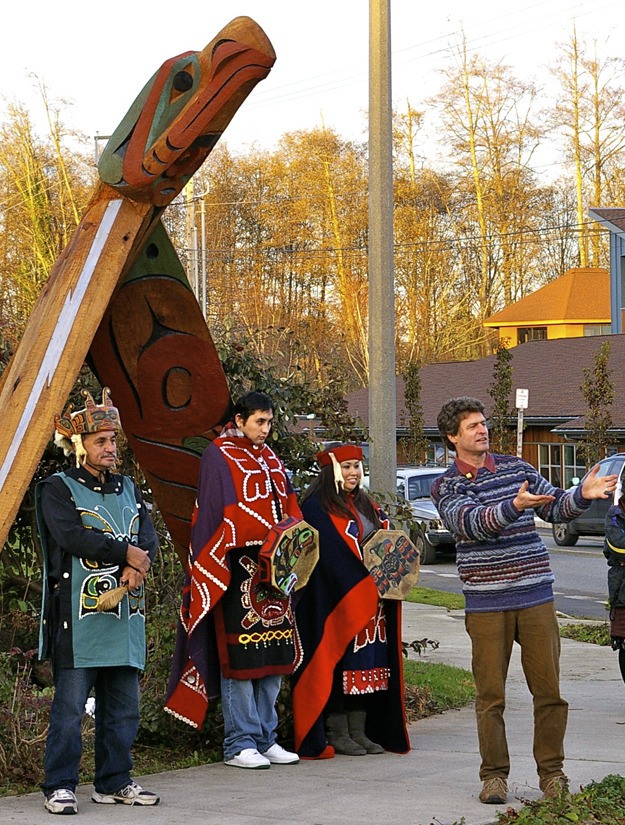The skies were clear Dec. 3 when a small group of people gathered on the corner of Madison Avenue and High School Road. The group had assembled to witness a blessing of a sculpture of a Thunderbird by Craig Jacobrown.
The carving “Rainbringer” purportedly brings rain, thunder and lightning. Within 10 days of the blessing ceremony, Bainbridge received more than four inches of rain, and not one, but two thunderstorms.
The original Rainbringer, which was installed in 1990 even before there was a roundabout, was damaged two years ago when a car hit the sculpture.
Instead of simply fixing the damaged wing, Jacobrown, of Indianola, carved a completely new “Rainbringer.”
Sue Anderson, who was chair of the public art committee of the Arts and Humanities Council, which commissioned the original work, remembers the blessing ceremony of the original carving.
“It was magical, beautiful,” she said. “There was a dance and a blessing by the tribal leader. As he was doing his dance, it started to rain slightly.”
Chief Henry Seaweed, to whom the sculpture is dedicated, led the blessing in 1990.
George Taylor, director and lead singer of the Lelala Dance Society, a family of traditional singers and dancers of the Kwakwaka’wakw (Kwakiutl) Nation, led the Dec. 3 blessing. He is a cousin of Seaweed. Both were invited and hosted by Jacobrown in acknowledgement of the carving’s subject, a Thunderbird, which is their clan crest.
Jacobrown, who first studied with well-known carver Duane Pasco, met Henry Seaweed, a renown Kwakwaka’wakw dancer while attending a retrospective of the work of Henry’s father, Willie Seaweed. Jacobrown began an apprenticeship and relationship with Henry and his extended family as a carver, attendant and assistant to the Lelala Dance society, which is how he met Taylor.
Jacobrown, a carver, storyteller and performing artist, said Taylor has shared with him the story of the Thunderbird. He’d like to bring the story to life for the island in a dedication that involves more of the Bainbridge community.
“It’s important to me to involve the local kids,” Jacobrown said.
In preparation for the Dec. 3 blessing, Jacobrown worked with fourth-grade students at Madrona School, making Northwest-style drums. The students were taught songs and asked to help welcome the visiting Kwakwak’wakw delegates.
In 1990, Jacobrown involved middle school students in making giant-scale puppets to depict the story of Thunderbird.
His hope is to find a willing teacher or teachers who will incorporate an art project and cultural study into their lesson plan for a dedication sometime in 2011.
Jacobrown still has the original Thunderbird from the 1990 dedication. He’d like to present a contemporary adaptation of the traditional Thunderbird story. Instead of the bird hunting and landing a whale, Jacobrown envisions the Thunderbird clenching the “Salish Sea Monster” in its mighty talons.
The antagonist, who is made from ubiquitous plastic debris found on local beaches, made its debut at the Great Peninsula Future Festival in July. Still, Jacobrown said, the 15-foot leviathan would benefit from the TLC of “one more class.”
For more information, visit www.themaskery.com/hamumu.



